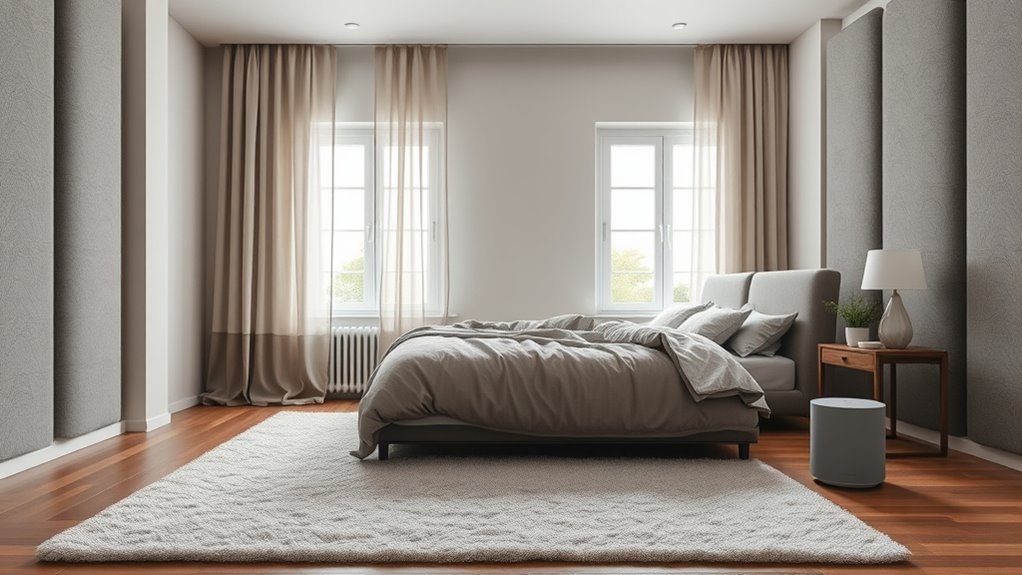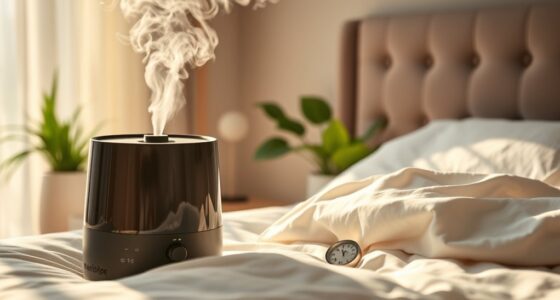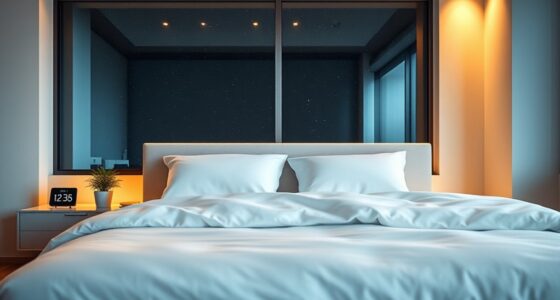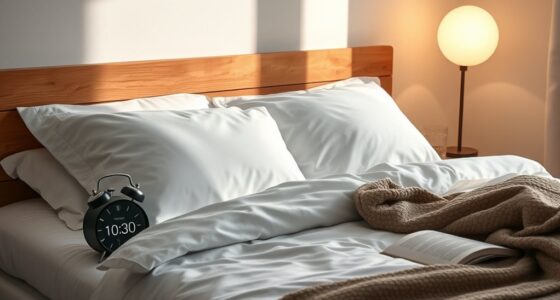For peaceful sleep, combine soundproof curtains, white noise machines, and sealing sound leaks around windows and doors. Use thick curtains to block outside noise, while white noise machines mask remaining sounds with soothing hums. Adding rugs and wall panels can improve sound absorption. This layered approach helps create a quiet, restful bedroom. Want to learn more tips to make your sleep environment even more peaceful? Keep exploring to discover effective solutions tailored for you.
Key Takeaways
- Use soundproof curtains to block external noise and create a quiet bedroom environment.
- Incorporate white noise machines to mask residual sounds and promote restful sleep.
- Combine curtains and white noise for a comprehensive noise reduction strategy.
- Seal gaps and add sound-absorbing materials like rugs and wall panels for enhanced quietness.
- Implement multiple noise control methods to maximize sleep quality and overall well-being.
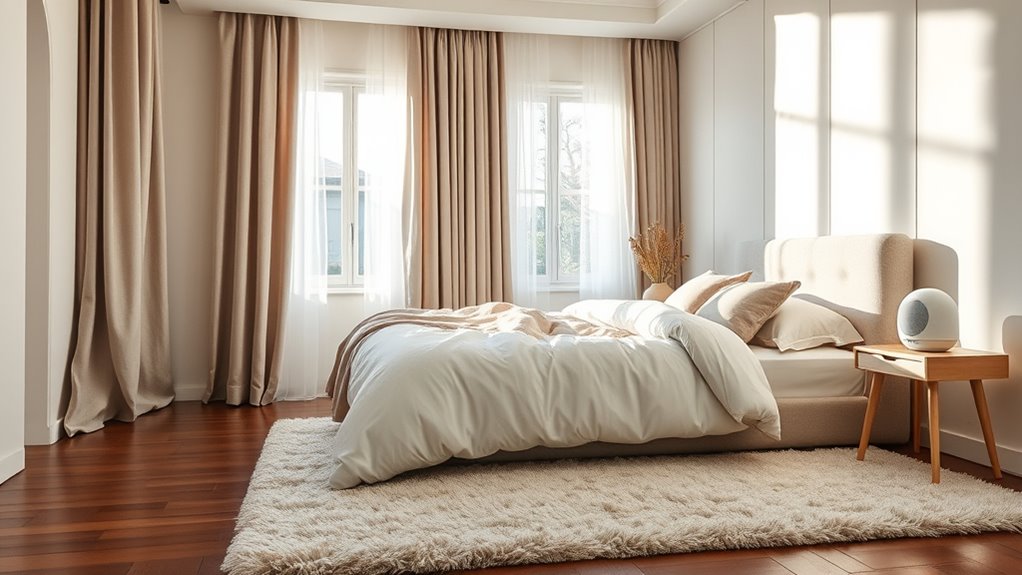
A quiet bedroom is essential for restful sleep and relaxation, but noise from outside or inside sources can disrupt your peace. Luckily, there are effective solutions to minimize disturbances and create a calming environment. One popular option is installing soundproof curtains. These thick, dense fabrics help block out external sounds like traffic or noisy neighbors, making your room a more serene space. When you draw them closed at night, you’ll notice a significant reduction in ambient noise, helping you fall asleep faster and stay asleep longer. Soundproof curtains are easy to hang and can be combined with other soundproofing methods for even better results. They’re also stylish, so you don’t have to sacrifice aesthetics for function. Additionally, the variety of designs available allows you to match your bedroom decor while enhancing noise reduction.
Soundproof curtains create a peaceful, noise-reducing sanctuary in your bedroom.
Another highly effective approach is using white noise machines. These devices produce a consistent, soothing background sound that masks disruptive noises. Whether it’s the honking of horns or upstairs footsteps, white noise machines create a uniform soundscape that your brain perceives as less jarring. This steady sound helps to drown out sudden or loud noises, preventing them from waking you up or disturbing your sleep cycles. Many white noise machines come with various sound options, like gentle rain or ocean waves, so you can choose what’s most relaxing for you. They’re compact and easy to operate, making them a convenient addition to your bedroom setup.
To maximize noise control, consider combining soundproof curtains with a white noise machine. While curtains block or absorb some external sounds, the white noise machine actively masks whatever noise does slip through. This dual approach offers a more holistic solution, especially if you live in a noisy neighborhood or have thin walls. Remember to position the white noise machine correctly – away from your bed but close enough to fill the room with sound. Adjust the volume to a comfortable level that drowns out unwanted noise without being intrusive or disruptive to your sleep.
In addition to curtains and white noise machines, think about other minor adjustments, like sealing gaps around windows and doors, or adding rugs and wall panels to improve sound absorption. Creating a peaceful sleeping environment involves multiple layers of noise reduction, but starting with soundproof curtains and a white noise machine will make a noticeable difference. Using soundproofing materials tailored for bedrooms can further enhance your noise reduction efforts. With these tools, you’ll achieve a quieter, more restful bedroom that promotes deep, uninterrupted sleep, helping you wake up refreshed and ready for the day.
Frequently Asked Questions
What Are the Best Materials for Soundproofing Bedroom Walls?
You should consider using acoustic panels and soundproof curtains for your bedroom walls. Acoustic panels absorb sound waves, reducing noise transfer, while soundproof curtains block external sounds and add an extra layer of insulation. Combining these materials creates a quieter environment, helping you sleep peacefully. Make sure to install them properly for maximum effectiveness, and enjoy a more restful night free from unwanted noise disturbances.
How Can Furniture Placement Reduce Noise in Bedrooms?
You can reduce noise in your bedroom by carefully arranging your furniture. Position large pieces like bookshelves and wardrobes against shared walls to block sound transfer. Use room layout strategies, placing beds away from noisy windows or doors, and add soft furnishings like upholstered chairs or rugs to absorb sound. Don’t worry—these simple furniture arrangements can make your space more peaceful, helping you enjoy restful sleep every night.
Are There Electronic Devices That Help Block Outside Noise?
Yes, you can use electronic devices like white noise machines and noise-canceling headphones to block outside noise. White noise machines create a consistent background sound that masks disruptive noises, helping you sleep better. Noise-canceling headphones actively reduce ambient sounds, providing a quiet environment. Both options are effective for minimizing external noise, making it easier to relax and fall asleep peacefully even in noisy surroundings.
What Are Quick DIY Solutions for Noise Reduction?
Think of noise reduction as quieting a busy city street. You can quickly block out sound with DIY window plugs—stuffing cotton or foam into your windows—or try heavy curtain hacks by hanging thick, layered curtains to absorb noise. These simple solutions act like a cozy barrier, turning your bedroom into a peaceful oasis. They’re fast, affordable, and effective at creating a serene sleep environment.
How Does Window Quality Affect Bedroom Noise Levels?
Your window quality directly impacts bedroom noise levels. Upgrading to well-insulated windows enhances soundproofing by reducing noise transmission. Adding soundproof curtains or heavy drapes further blocks sound, creating a quieter sleeping environment. Proper window insulation minimizes gaps and leaks, preventing outside noise from entering. Combining high-quality windows with soundproof curtains offers a cost-effective way to markedly decrease unwanted noise and achieve peaceful sleep.
Conclusion
Imagine slipping into your bedroom, the world outside fading away as peaceful silence wraps around you like a cozy blanket. With a few simple steps—adding soft rugs, sealing gaps, or using white noise—you create a tranquil sanctuary where restful sleep becomes effortless. Say goodbye to restless nights and hello to serene mornings. Your ideal peaceful sleep zone is within reach; all it takes is a little noise control to turn your bedroom into your personal retreat.
